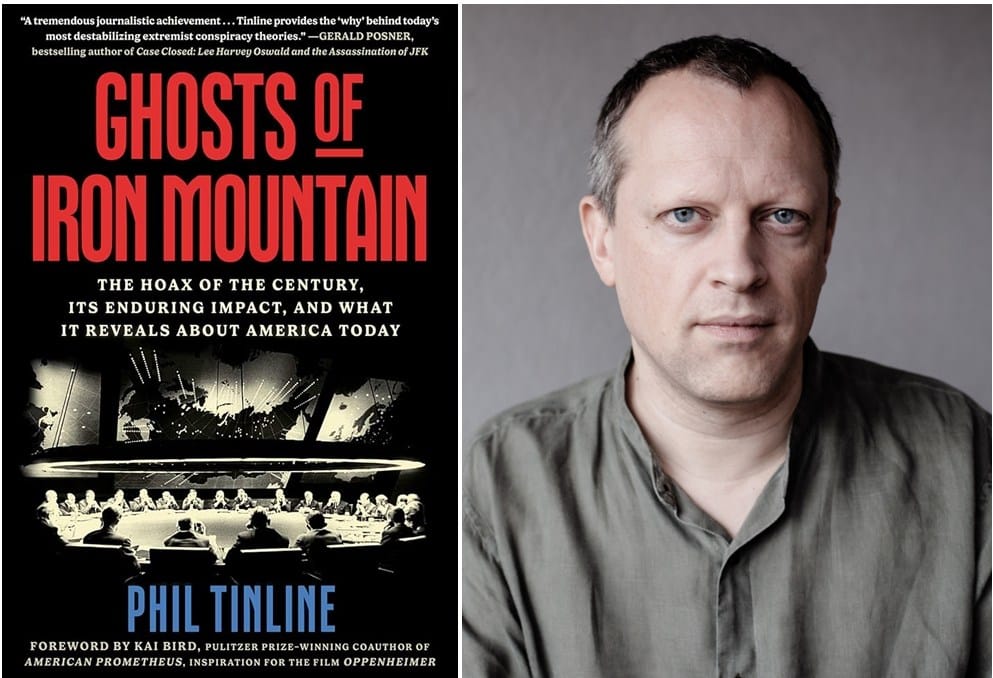Phil Tinline’s Ghosts of Iron Mountain: The Hoax of the Century, Its Enduring Impact, and What It Reveals About America Today is a story of power, hubris, and its costs. It looks at a 1967 spoof of the American establishment that struck a nerve in the highest circles of authority as it became a New York Times bestseller. Since then, the book has rippled through the public domain for more than 50 years, landing in the “burgeoning right-wing ecosystem” of the present day.(135)
In its original form, Report from Iron Mountain on the Possibility and Desirability of Peace appeared as an official document, a think tank product among the many produced by a cottage industry attached to U.S Cold War policy making. The report endorsed the idea of a “permanent war economy” as the best means to sustain both prosperity and the military-industrial complex’s control over the “cheerful robots” making up mainstream American society. (8-9) Report from Iron Mountain was, for all intents, the worst case dystopian scenario discussed in works like C. Wright Mill’s The Power Elite, what Tinline describes as “the malign omnipotence of the military-industrial complex.”(155)
There was a human face to these fears. A post-1945 generation of intellectuals, corporate leaders, and public officials — Herman Kahn, Robert McNamara, Henry Kissinger, and Walt Rostow to name a few — were the guiding lights of Cold War policy and domestic affairs. David Halberstam discussed them in The Best and the Brightest,: “The new men were tough—‘hard-nosed realists’ was a phrase used to define them, a description they themselves had selected.”
They dominated public affairs because they presented themselves as innovative, efficient, “dazzlingly scientific,”(19) and, most of all, objective. They were very briefly heroes, the type of leadership that could send a man to the Moon, win the “War on Poverty,” and reshape the “Free World” as we knew it.
And, in too many important moments in American history, they failed miserably. Apollo 11 did reach the Moon. However, Lyndon Johnson’s Great Society — for all it accomplished — did not result in a new American consensus. The Alliance for Progress in Latin America prompted a generation of reactionary authoritarian regimes. According to Tinline, “the demands of managing the incomprehensible stakes of the arms race had led intelligent men to demand maximum rearmament on the back of guesswork and self-delusion.”(13) The prime example of this mistake was Vietnam, where the fruitless pursuit of Cold War containment policy exacted a heavy toll on U.S. institutions and public trust in them.
The 1967 version of Report from Iron Mountain gradually faded once author Leonard Lewin conceded it was a hoax, but the book lived on as it was resurrected by the fringes of the American right. Tinline offers a simple reason: “The high walls of the post-1945 national security state had become a blank canvas onto which left and right alike could project all sorts of fearful imaginings.”(161) In effect, confirmation bias dictated the terms of the book’s legitimacy and traction.
Ghosts of Iron Mountain shines in its examination of how we treat the truth. The topic dominated debates at the end of the 1960s, a period bracketed by a multiplying list of Kennedy conspiracy theories and the Pentagon Papers. Neoconservative Irving Kristol commented in 1968: “Are we becoming a nation in which all obvious truths are suspect and only political fantasies are credible?”(107)
The fact of the matter was that we were, and a major reason for the problem was official U.S. policy. The Cold War is littered with instances of official deception with the end goal of prevailing over communism. This is what informed “plausible deniability” when the White House tried to avoid responsibility for U-2 overflights into the Soviet Union in 1960. It is what fed cynicism during official military press conferences in South Vietnam, “the five o’clock follies,” and led Neil Sheehan to write his outstanding A Bright Shining Line (1988). Deception and illegality were at the heart of the “imperial presidency” under Nixon, something he recognized in his 1977 interview with David Frost: “Well, when the president does it … that means that it is not illegal.”
READ: New Book Offers Insights Into Why the United States Is a Country ‘Marinated in Conspiracy Theory’
Unfortunately, the American Left was not immune to the same hubris. In the chapter “Mr. X and the High Cabal,” Tinline uncovers the link between retired Colonel Leroy Fletcher Prouty, a career Army officer with deep involvement in Cold War covert operations, and director Oliver Stone. Despite his intelligence background and Leonard Lewin’s admission that Report from Iron Mountain was fake, Prouty accepted the book as real and passed along that agency to Stone while he was preparing his screenplay for JFK. The all-encompassing mega conspiracy at the heart of the film, presented by “Mr. X,” a character based on Prouty, is from the Report from Iron Mountain. JFK proved to be a lightning rod for historians and commentators in general, many of whom pointed out a string of baseless claims, overgeneralizations, and outright fiction.(158-159) Roger Ebert dodged the issue by complimenting the film’s “emotional truth.” Stone was nonplussed by this criticism. According to Tinline: “in its attempt to fight power and reassert the truth, the movie claimed that the historical record was secondary to what Stone called ‘the inner truth’.”(164) In an ironic callback to the Warren Commission, JFK’s ends justified its means.
Postmodernism abetted Oliver Stone and found a new platform in his work. In its skepticism of Western tradition and attack on objectivity, postmodernists promoted an ongoing debate about the nature of truth and subjectivity. This position could be a healthy addition to academe. However, as James N. Giglio wrote in his 1992 review of JFK, such relativism and its distortion of history “is potentially dangerous to an alienated and uneducated public.”
This is exactly where we are today. The original audience for Report from Iron Mountain were emerging white collar Baby Boomers, “young graduates rising fast in government, law, and publishing: ‘the people who would be running things’.”(71) They subscribed to Esquire and the New York Times, and understood nuanced satire as practiced by Mort Sahl, Dick Gregory, Monty Python, and the first incarnation of Saturday Night Live.
The original audience for Report from Iron Mountain is now joined by people who flocked to Glenn Beck, Alex Jones, the Tea Party movement, and who now follow QAnon, and see the “deep state” in virtually every part of life. (237) What separates past and present audiences has less to do with their mutual suspicion of power and more about what constitutes a credible narrative.
We are long past the old emphasis on empirical objectivity, either a clever mimicking of it or the real thing. Today, what dominates much of the discussion is what sociologist Arlie Russell Hochschild calls the “feels-as-if story.”(241) This contemporary approach is intuitive rather than factual. “It removes judgement. It removes fact. It tells us how things feel.”(241) Consequently, the wall between satire and reality, between news and entertainment has broken down. This process has been decades in the making, something Matt Taibbi covered at length in Hate Inc.(2019)
American politicians have understood this reality for quite a long time. When he entered the presidential race in 1992, Bill Clinton recognized the intangible value of empathy — “I feel your pain” — as the country navigated a sharp recession. Republicans pursued the same tact in a different direction. When Ted Cruz first ran for Senate in 2012, he invoked Agenda 21 conspiracies on Glenn Beck’s radio show.(229) Donald Trump simply took the same process of suspicion and grievance straight into presidential politics because he understood an already well traveled path in American media and society.
There is an irony here. The respective backgrounds of Clinton, Cruz, and Trump illustrate a common denominator that C. Wright Mills might have easily spotted. All three are products of institutions, Georgetown, Oxford, Yale (Clinton), Princeton, Harvard (Cruz), and Wharton (Trump), that are mainstays of the power elite. Yet, all three successfully shed this association by being virtuosos of the “feels-as-if story.”Ghosts of Iron Mountain is an excellent book. It carefully traces the evolution of justified skepticism of authority from well-crafted satire to ungrounded conspiracy theories. Although it will not solve the basic problem of trust that plagues modern America, it will certainly move the needle in the right direction of rationality for the careful reader. Much like the original book.







